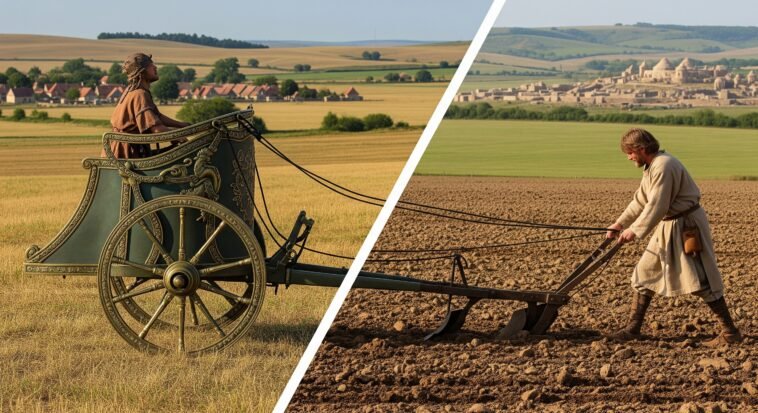
The jump from the Bronze Age to the Iron Age was like upgrading from a flip phone to a smartphone—only for tools and societies.
This shift wasn’t just about swapping out metals; it totally changed how people worked, traded, and lived their daily lives around the world.
Getting what made these ages different helps us see how early civilizations leveled up and laid the groundwork for, well… everything we have now.
Understanding the Ages: Bronze and Iron
The Bronze Age (circa 3300–1200 BCE)
Think of the Bronze Age as humanity’s first major “upgrade.”
People mixed copper and tin to make bronze—a tougher, shinier metal perfect for tools, weapons, and fancy artifacts.
This era gave us some OG civilizations like Mesopotamia, Ancient Egypt, the Indus Valley, and China’s Shang Dynasty.
It was also when farming got smarter, writing popped up, and cities started looking like cities instead of campgrounds.
The Iron Age (circa 1200 BCE onwards)
Then came the Iron Age—kind of like switching from basic Netflix to streaming in 4K.
Iron was everywhere, easier to find than those tricky copper and tin combo parts.
People learned to smelt and shape iron into tools and weapons that were stronger and more reliable.
This shift shook up warfare, farming, and how societies were organized, helping empires grow and culture evolve in some pretty epic ways.

Key Differences Between the Bronze and Iron Ages
1. Material composition and availability
Bronze:
This was the OG metal mix—a combo of copper and tin.
But here’s the catch: tin was pretty rare and often had to travel long distances, kind of like that limited-edition sneaker drop you had to wait weeks for.
So, bronze wasn’t just a metal; it was a status symbol that depended on massive trade networks.
Iron:
Enter iron, the all-you-can-mine buffet. Iron ore is everywhere, which meant more people could jump into the metal game without waiting for that rare tin hookup.
Why it matters:
Bronze made societies play global trade chess, but iron gave more regions their own “metalworking starter pack.”
Suddenly, making tools and weapons wasn’t just for the elite anymore—it was open season.
2. Technological advancements
Bronze age:
During the Bronze Age, folks mastered casting techniques—think of it like pouring molten metal into molds to make swords, axes, and all kinds of shiny gear.
Iron age:
When the Iron Age rolled around, the game changed with forging—hammering heated iron to shape stronger, tougher tools and weapons.
It’s like upgrading from a basic kitchen knife to a chef’s knife that slices through everything.
Why it matters:
Iron tools lasted longer and worked better, which meant farms grew more food and armies fought harder.
It was a tech upgrade that boosted everyday life and war strategies alike.
3. Societal and economic structures
Bronze age:
The Bronze Age was all about centralized societies with big trade networks and clear class divisions.
Imagine a high-stakes game of Monopoly where the rich controlled the best properties (and metals).
Iron age:
The Iron Age shook things up. Iron’s availability helped local economies grow and gave rise to new social classes—sort of like leveling the playing field in that Monopoly game.
Why it matters:
Iron led to a kind of “metal democratization,” where tool and weapon-making wasn’t just for the elite anymore.
This shifted power dynamics, making societies more complex and sometimes more competitive.
Warfare and military organization
Bronze age:
In the Bronze Age, bronze weapons were expensive, so armies were smaller and often made up of elites—think of knights in shining armor, but with bronze instead of steel.
Iron age:
When iron took over, weapons became cheaper and more widespread.
Suddenly, larger armies were possible, and military tactics evolved.
It was like going from a small indie band to a full-on rock festival.
Why it matters:
With iron weapons in many hands, conflicts became more frequent and larger in scale.
This contributed to the rise (and fall) of empires—because when more people have swords, things get interesting real fast.

Cultural and Environmental Impacts
Urbanization and settlement patterns
The Iron Age wasn’t just about cooler tools—it sparked a housing boom, too.
Fortified settlements like hillforts popped up everywhere, acting like the medieval version of gated communities.
These spots became hubs for trading goods, running governments, and defending against the occasional raid—think Game of Thrones, but with fewer dragons and more pitchforks.
Agricultural practices
Iron tools gave farmers a serious upgrade.
With stronger plows and hoes, they could work tougher soil and farm more land than ever before.
This boost didn’t just fill stomachs—it fueled population growth and pushed communities to spread out and develop smarter farming techniques.
Basically, Iron Age farmers went from “meh” to “master of the fields.”
Environmental changes
But here’s the catch: all that iron smelting came with a cost.
Mining and forging required tons of wood for charcoal, which meant cutting down massive forests.
Imagine Iron Age deforestation as history’s version of a wildfire season, but caused by humans hungry for metal.
These environmental shifts reshaped landscapes and ecosystems, leaving a mark that lasted for centuries.

Wrapping It Up: Why the Bronze-to-Iron Switch Was a Big Deal
Switching from bronze to iron wasn’t just an upgrade—it was a total reboot for humanity. Iron toughened tools, shook up societies, and even changed the environment.
Think of it as the OG “refresh” button that shaped how we live and work today.
So next time you grab something metal, remember—you’re holding a piece of history that leveled up the world, one ironclad move at a time.



